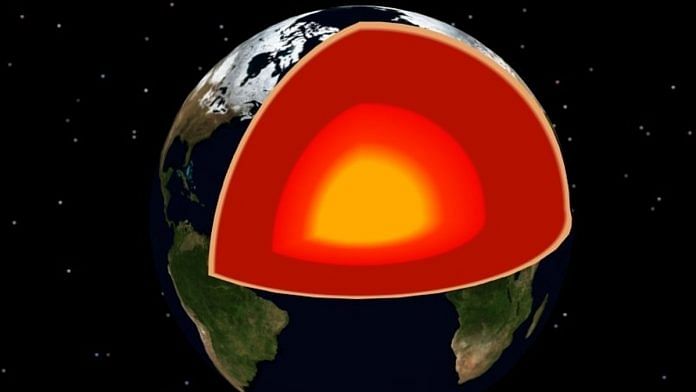Earth’s inner core is seeing an asymmetric growth
The Earth’s solid-iron inner core is growing faster on one side than the other, said a new study by seismologists at the University of California, Berkeley, US.
According to the study, the inner core has been growing faster on one side ever since it started to freeze out from molten iron more than half a billion years ago. However, this does not mean that the core is lopsided. Gravity evenly distributes the new growth to maintain a spherical inner core that grows in radius by an average of 1 millimeter per year.
But the enhanced growth on one side suggests that something in Earth’s outer core or mantle under Indonesia is removing heat from the inner core at a faster rate than on the opposite side, under Brazil. Quicker cooling on one side would accelerate iron crystallisation and inner core growth on that side.
This has implications for Earth’s magnetic field and its history, because convection in the outer core driven by release of heat from the inner core is what today generates the magnetic field that protects us from dangerous particles from the sun.
Asymmetric growth of the inner core explains a three-decade-old mystery — that the crystallised iron in the core seems to be preferentially aligned along the rotation axis of the earth, more so in the west than in the east, whereas one would expect the crystals to be randomly oriented. More on Science Focus.
Also read: NASA announces two new missions to Venus as it seeks to ‘rediscover the planet’
Nearest, most energetic gamma-ray radiation detected
An observatory in Namibia has recorded the most energetic radiation and longest gamma-ray afterglow of a so-called gamma-ray burst (GRB) to date — giving scientists the best ever view of the brightest explosions in the universe.
The observations with the High Energy Stereoscopic System challenge the established idea of how gamma-rays are produced in these stellar explosions which signal the birth of black holes.
GRBs are bright X-ray and gamma-ray flashes observed in the sky emitted by distant extragalactic sources. They are the biggest explosions in the universe.
They are associated with the collapse of a rapidly rotating massive star to a black hole.
The burst is divided into two distinct phases — an initial chaotic prompt phase lasting tens of seconds, followed by a long-lasting, smoothly fading afterglow phase.
In August 2019, a GRB was detected in the constellation of Eridanus. The event, cataloged as GRB 190829A, turned out to be one of the nearest gamma-ray bursts observed so far, with a distance of about one billion light years. More on Space.com.
Also read: Older people may need 3rd shot to stay protected against Delta Covid variant: Lancet study
Scientists create fungus to protect bees from mites
A team at the Washington State University in the US has bred a strain of a fungus that can protect bees against varroa mites without the use of chemical pesticides.
Varroa destructor mites are small parasites that live on honey bees. They play a large role in Colony Collapse Disorder, which causes beekeepers to lose 30-50 per cent of their hives each year.
The mites feed on bees, weakening their immune systems and making them more susceptible to viruses.
Known as metarhizium, the strain created by the researchers can survive in the warm environments common in honey bee hives, which typically have a temperature of around 35 Celsius.
Although metarhizium was known to kill mites, its use was expensive and it didn’t last long because the fungi died in the hive heat.
When spores of the fungus land on a varroa mite, they germinate, drill into the mite, and proliferate, killing it from the inside out. Bees have high immunity against the spores, making it a safe option for beekeepers. More on Science Mag.
Tyrannosaurus rex developed powerful bites by teens
A new study shows that by the age of 13, the bite force of a Tyrannosaurus rex could already puncture an animal bone.
The study fills a gap in the knowledge about what the world was like in the late Cretaceous Period.
For the study, researchers replicated bite marks made in a fossilised dinosaur bone made by a juvenile T. rex. The researchers made a metal replica of a tooth of a 13-year-old T. rex, and mounted it on a mechanical testing frame commonly used in engineering and materials science. They then tried to crack a cow leg bone with it.
Based on 17 successful attempts to match the depth and shape of the bite marks on the fossils, they determined that a juvenile could have exerted up to 5,641 newtons of force, somewhere between the jaw forces exerted by a hyena and a crocodile.
In comparison the bite force of an adult T. rex is about 35,000 newtons and that of humans is about 300 newtons.
Bite force measurements can help paleontologists understand the ecosystem in which dinosaurs — or any extinct animal — lived, and which predators were powerful enough to eat which prey, and what other predators they competed with.
The study reveals that juvenile T. rexes, while not yet able to crush bones like their 30- or 40-year-old parents, were developing their biting techniques and strengthening their jaw muscles to be able to do so once their adult teeth came in. More on SciTechDaily.
Also read: Fauci dismissed IIT-Delhi Covid paper as ‘outlandish’ — what it said & why it was withdrawn






